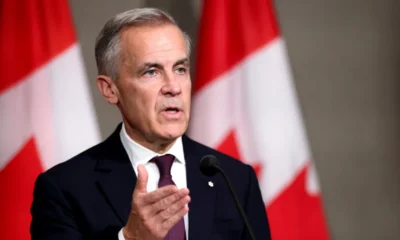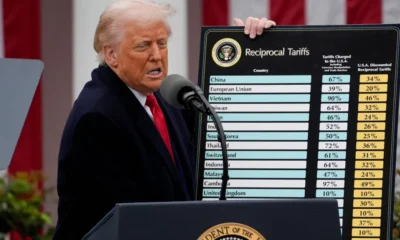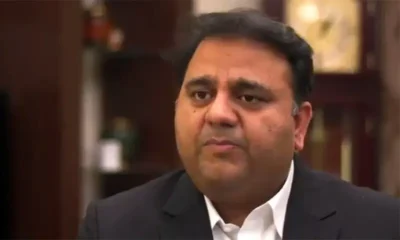American News
Fed cuts US interest rates again despite ‘flying blind’

The US Federal Reserve pushed forward with an interest rate cut as inflation fears continue to take a backseat to concerns about a stalling labour market.
It came despite the US government shutdown, nearing its one-month mark, which delayed official data and left central bankers “flying blind” about the job market, economists said.
The US central bank said on Wednesday it was lowering the target for its key lending rate by 0.25 percentage points, putting it in a range of 3.75% to 4%.
The Fed last month cut interest rates for the first time since last December. Economists expected the move to jump-start further reductions, but the data drought means the trajectory for future cuts looks murky.
Two voting members on the Fed’s committee opposed the central bank’s decision on Wednesday.
Stephen Miran, who is on leave from his post leading US President Donald Trump’s Council of Economic Advisers, voted for a larger 0.5 percentage point cut. Jeffrey Schmid, president of the Federal Reserve Bank of Kansas City, voted to hold rates steady.
The Fed’s latest cut brings the target for its key lending rate down to its lowest level in three years, easing borrowing costs across the US.
A slowdown in job hiring prompted the Fed to restart its rate cutting cycle in September. In a policy statement on Wednesday, the central bank reiterated that “job gains have slowed this year” and that the unemployment rate, though still low through the end of summer, has now “edged up”.
At a press conference following the cut, Fed chair Jerome Powell called the labour market “less dynamic and somewhat softer” than earlier this year, pointing in part to lower immigration.
Still, he said weakness in the job market does not appear to be accelerating.
But the ongoing government shutdown has stalled the release of the official monthly jobs report for September, limiting central bankers’ insight into how the labour market has fared since their last meeting.
Alternative sources including private-sector data have pointed to an ongoing trend of sluggish hiring. The US economy lost 32,000 jobs in September, according to data from the payroll firm ADP.
The Labor Department did release inflation data for September last week. The figure, at 3% year-over-year, was slightly lower than economists had predicted, reinforcing the likelihood that rate-setters would vote to lower borrowing costs again.
Fears about tariff-driven inflation had taken centre stage earlier this year when Trump pushed forward with sweeping tariffs on many of the country’s largest trading partners.
Inflation is still above the Fed’s 2% target. But while tariffs appear to be boosting some consumer prices, the milder-than-expected inflation reading for September allowed the Fed to focus on boosting the labour market by lowering rates, economists at Bank of America noted.
“Inflation away from tariffs is actually not so far from our 2% goal,” Powell told reporters. He said the hope among central bankers is that tariffs only lead to one-time price increases for certain consumer products.
The Fed on Wednesday also said it will stop shrinking its balance sheet – its portfolio of government debt and mortgage-backed securities – on 1 December.
For more than three years, the central bank has undertaken a process to unwind its purchases during the pandemic and previous financial crises, when it aimed to boost the economy and bring down interest rates. That unwinding process is now poised to end, as widely anticipated, amid signs of stress in financial markets.
‘Strongly differing views’ on a December cut
Wall Street had been betting on another quarter-point interest rate cut from the central bank at its last meeting of the year in December.
But those bets fell after Powell on Wednesday stressed that a December cut is “not to be seen as a foregone conclusion – in fact, far from it”.
“Future moves are becoming more contentious,” said Michael Pearce, deputy chief US economist at Oxford Economics. “We expect the Fed to slow the pace of cuts from here.”
A lot might still change before the Fed’s next meeting. It could receive three new jobs reports, which could “significantly change perceptions of the labour market for better or worse”, Michael Feroli, chief US economist at JP Morgan, wrote in a note.
At the same time, if the government shutdown persists and continues to limit the availability of government data, that could also encourage the Fed to sit on its hands at the end of the year.
“What do you do if you’re driving in the fog? You slow down,” Powell said.
He told reporters that “there were strongly differing views about how to proceed” among members of the Fed’s committee, and the decision will ultimately depend on incoming economic data.
“We’re going to collect every scrap of data we can find,” Powell said.
The Fed chair has been under pressure from President Trump, who has repeatedly called on him to lower interest rates.
Trump on Monday floated the possibility that he will announce a replacement for Powell, whose term ends next May, by end the end of this year.
American News
Conservative justices sharply question Trump tariffs in high stakes hearing
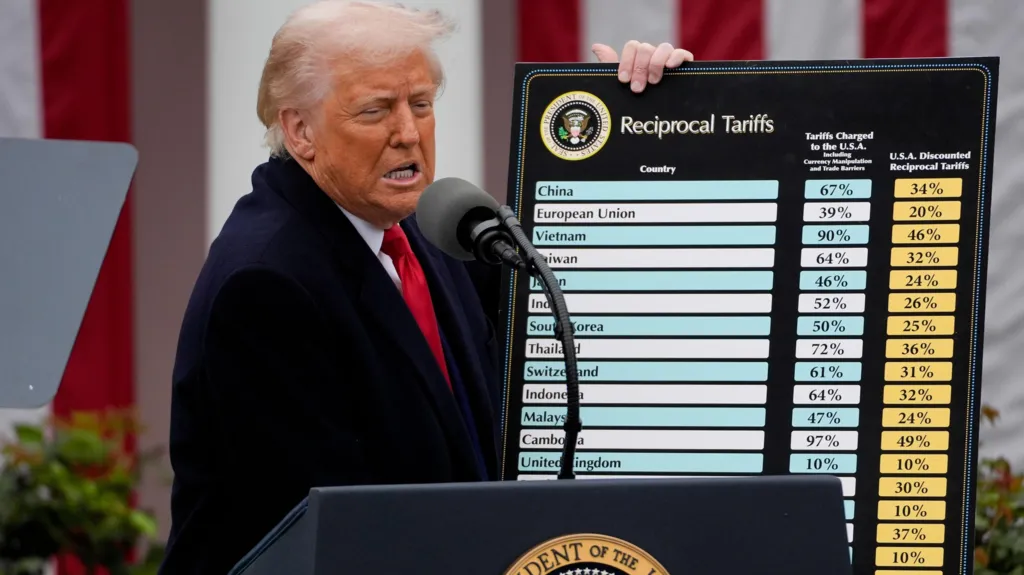
Donald Trump’s sweeping use of tariffs in the first nine months of his second term was sharply questioned during oral arguments before the Supreme Court on Wednesday.
Chief Justice John Roberts, and justices Amy Coney Barrett and Neil Gorsuch – three conservative jurists considered swing votes in this case – peppered US Solicitor General John Sauer, representing the president’s administration before the court.
They were joined by the court’s three liberal justices, who also expressed scepticism about whether federal law – and the US Constitution – give the president authority to unilaterally set tariff levels on foreign imports.
“The justification is being used for power to impose tariffs on any product from any country in any amount, for any length of time,” Roberts said.
If the court ruled for Trump in this case, Gorsuch wondered: “What would prohibit Congress from just abdicating all responsibility to regulate foreign commerce?”
He added that he was “struggling” to find a reason to buy Sauer’s arguments.
In a possible sign of case’s complexities, the hearing stretched almost three hours – far longer than the time formally allotted.
Arguing over ‘country-killing’ crises
The case centres around a 1977 law, the International Emergency Economic Powers Act (IEEPA), that Trump’s lawyers have said gives the president the power to impose tariffs. Although the Constitution specifically vests Congress with tariff authority, Trump has claimed that the legislature delegated “emergency” authority to him to bypass longer, established processes.
Sauer asserted that the nation faced unique crises – ones that were “country-killing and not sustainable” – that necessitated emergency action by the president. He warned that if Trump’s tariff powers were ruled illegal, it would expose the US to “ruthless trade retaliation” and lead to “ruinous economic and national security consequences”.
Trump first invoked IEEPA in February to tax goods from China, Mexico and Canada, saying drug trafficking from those countries constituted an emergency.
He deployed it again in April, ordering levies from 10% to 50% on goods from almost every country in the world. This time, he said the US trade deficit – where the US imports more than it exports – posed an “extraordinary and unusual threat”.
Those tariffs took hold in fits and starts this summer while the US pushed countries to strike “deals”.
Lawyers for the challenging states and private groups have contended that while the IEEPA gave the president power to regulate trade, it made no mention of the word “tariffs”.
Neil Katyal, making the case for the private businesses, said it was “implausible” that Congress “handed the president the power to overhaul the entire tariff system and the American economy in the process, allowing him to set and reset tariffs on any and every product from any and every country, at any and all times”.
He also challenged whether the issues cited by the White House, especially the trade deficit, represent the kind of emergencies the law envisioned.
Suppose America faced the threat of war from a “very powerful enemy”, Samuel Alito, another conservative justice, asked. “Could a president under this provision impose a tariff to stave off war?”
Katyal said that a president could impose an embargo or a quota, but a revenue-raising tariff was a step too far.
For Sauer, this was a false choice. Presidents, he said, have broad powers over national security and foreign policy – powers that the challengers want to infringe on.
Tariffs v taxes
A key question could be whether the court determines whether Trump’s tariffs are a tax.
Several justices pointed out that the power to tax – to raise revenue – is explicitly given to Congress in the Constitution.
Sauer’s reply was that Trump’s tariffs are a means of regulating trade and that any revenue generated is “only incidental”.
Of course, Trump himself has boasted about the billions his tariffs have generated so far and how essential this new stream of funding is to the federal government.
The justices spent very little time on questions about refunds or whether the president’s emergency declarations were warranted. Instead they spent most of their time examining the text of IEEPA and its history.
Sauer urged them to understand tariffs as a natural extension of other powers granted to the president under the law rather than a tax. “I can’t say it enough – it is a regulatory tariff, not a tax,” he said.
But that appeared to be a stumbling block for many of the justices.
“You want to say that tariffs are not taxes but that’s exactly what they are,” Justice Sotomayor said.
Many seemed persuaded by arguments from the business and states that tariffs, as a tax paid by US businesses, were fundamentally different from the other kinds of powers addressed by the law.
But not all.
Justice Kavanaugh expressed doubts on that point toward the end of the hearing, saying it didn’t seem to very “common sense” to give the president the power to block trade entirely, but not impose a 1% tariff, sugggesting it left a gap like a donut hole.
“It’s not a donut hole. It’s a different kind of pastry,” Gutman responded, drawing chuckles in the crowd.
What the court’s ruling could do
Treasury Secretary Scott Bessent, who attended the hearing, made no comment when asked by the BBC what he thought of the hearing. Secretary of Commerce Howard Lutnick, also in court, flashed a thumbs-up.
US Trade Envoy Jamieson Greer was in court, along with Minnesota Senator Amy Klobuchar, who said outside after arguments that she was “hopeful” based on the questions asked that the court would overturn the tariffs.
“I thought they were very good questions,” she said, describing tariffs as an “unconstitutional power grab” by the president.
The hearing drew a full audience, with press pushed into overflow seats behind columns.
If a majority of the Supreme Court rules in Trump’s favour, it will overturn the findings of three lower courts that already ruled against the administration.
The decision, no matter how it works out, has implications for an estimated $90bn worth of import taxes already paid – roughly half the tariff revenue the US collected this year through September, according to Wells Fargo analysts.
Trump officials have warned that sum could swell to $1tn if the court takes until June to rule.
During oral arguments, Barrett grappled with the question of reimbursing such revenue, wondering if it would be a “complete mess”.
Katyal responded by saying that small businesses might get refunds, but bigger companies would have to follow “administrative procedures”. He admitted that it was a “very complicated thing”.
In remarks on Wednesday, press secretary Karoline Leavett hinted that the administration already is looking at other ways to impose tariffs if the Supreme Court rules against them.
“The White House is always preparing for Plan B,” she said. “It would be imprudent of the president’s advisors not to prepare for such a situation.”
American News
Canada Ad That Rattled Trump
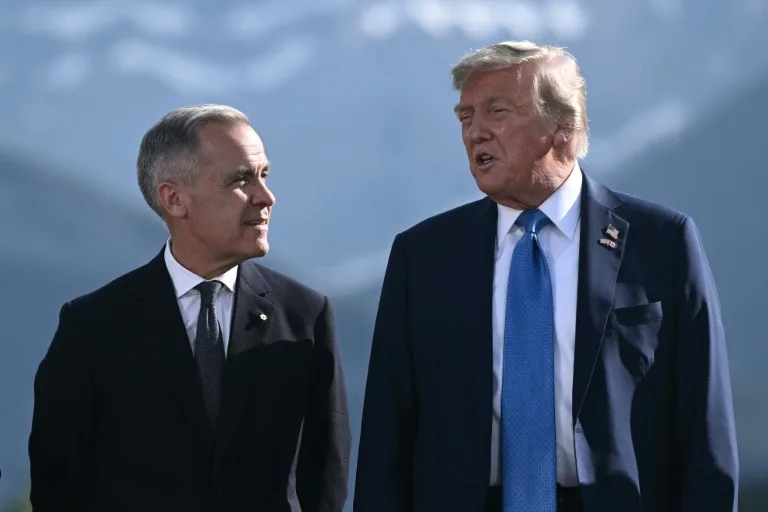
Paris (Imran Y. CHOUDHRY) :- Former Press Secretary to the President, Former Press Minister to the Embassy of Pakistan to France, Former MD, SRBC Mr. Qamar Bashir analysis : In October 2025, a seemingly harmless Canadian public-service announcement featuring Ronald Reagan’s 1987 speech on tariffs ignited an international political storm. What began as a provincial media campaign by Ontario quickly escalated into a full-blown trade confrontation with the United States—one that exposed the fragility of U.S.–Canada relations in the Trump era and the fine line between political messaging and economic provocation.
The ad opened with archival footage of Reagan declaring, “Protectionism is destructionism. Tariffs and quotas are barriers that protect the few at the expense of the many.” The message, originally delivered at the height of the Cold War, was reinterpreted by Ontario’s communications bureau as a critique of modern tariff nationalism. The closing frame read, “Free trade built North America. Tariffs break it.” The timing was deliberate. It aired just days after President Donald J. Trump announced a 5% tariff increase on Canadian steel, aluminum, and agricultural imports—part of his renewed “America First Fair Trade” agenda.
For Trump, the ad wasn’t merely a disagreement over policy; it was personal. The president viewed the Reagan montage as a deliberate distortion of a conservative icon’s legacy—one that painted Trump as an economic isolationist rather than a nationalist reformer. Within hours of the broadcast, the White House communications team condemned the ad as “foreign political interference in U.S. policy discourse.” Trump himself took to Truth Social, writing: “Fake Reagan quotes, fake Canada leadership. We’re done talking until they apologize. New tariffs coming.”
The fallout was swift. Trump’s administration suspended ongoing trade negotiations aimed at refining the U.S.–Canada Economic Partnership Framework. He ordered a 10% across-the-board tariff increase on all Canadian imports, including automotive parts, lumber, dairy, and consumer goods. For two economies intertwined through $800 billion in annual trade, the move sent shockwaves through industries on both sides of the border. Trucking associations, small exporters, and retail chains immediately warned that price hikes were inevitable before the 2025 holiday season.
In Ottawa, Prime Minister Mark Carney acted quickly to contain the crisis. Although the advertisement originated from Ontario’s provincial government rather than the federal cabinet, Trump’s reaction forced Ottawa to intervene. In a carefully worded statement, Carney expressed “regret for any misunderstanding” and emphasized that “the ad does not reflect Canada’s federal stance on U.S. trade policy.” According to The Washington Post, Carney even reached out to Trump personally to offer an apology—an unusual act in modern diplomacy that underscored how high the stakes were.
Trump acknowledged the apology publicly but refused to lift the suspension of trade talks. “I appreciate Prime Minister Carney’s words,” he said during a Mar-a-Lago press briefing. “But actions speak louder than apologies. We’ll see if Canada really wants fair trade—not propaganda.”
The ad’s creators defended their intent, claiming it was meant to “highlight the historical value of free trade” rather than criticize Trump personally. Yet political analysts in both countries saw it as a textbook case of how symbolic gestures can spiral into real-world consequences. “Reagan’s words were about global cooperation against communism, not about contemporary tariff disputes,” explained Professor Samuel Pritchard of the University of Toronto. “Re-contextualizing them during an active negotiation with a protectionist White House was politically reckless, even if rhetorically clever.”
Canadian citizens were deeply divided. Some praised Ontario for “standing up for free trade principles,” seeing it as a proud reaffirmation of Reagan-era conservatism and cross-border partnership. Others accused the provincial government of jeopardizing livelihoods for political theater. Social-media platforms were soon flooded with hashtags such as #ReaganAdGate and #TariffWarNorth. Polls conducted by the Toronto Star indicated that 42% of Canadians supported the ad, while 47% thought it was ill-timed and diplomatically irresponsible.
For small business owners in Ontario and Quebec, the timing could not have been worse. Tariff hikes immediately disrupted auto-parts exports and timber shipments. The Canadian Chamber of Commerce estimated losses exceeding $2.4 billion within the first two weeks of the new tariff regime. The Toronto Stock Exchange saw its manufacturing index fall by nearly 4% in a single day—its steepest drop since early 2023.
In the United States, the political narrative was equally polarized. Trump’s supporters hailed the move as evidence of his “uncompromising defense of American workers,” while his critics accused him of hypersensitivity and using trade policy to punish political speech abroad. Several U.S. senators from border states, including Michigan and New York, quietly urged the administration to de-escalate, citing mounting pressure from local businesses dependent on cross-border supply chains.
Mark Carney’s apology, intended as a pragmatic gesture, triggered heated debate in Canada’s Parliament. Opposition leader Pierre Poilievre accused the prime minister of “bowing to American intimidation” and undermining Canadian sovereignty. Carney countered that leadership demanded “preventing a rhetorical dispute from turning into an economic war.” His cautionary tone reflected the grim reality that Canada could ill afford another prolonged tariff standoff, especially after years of global inflation and energy-price volatility.
Meanwhile, the United States began leveraging the dispute in broader trade negotiations with Europe and Mexico, signaling that Washington was prepared to use tariffs not merely as economic tools but as instruments of political discipline. Analysts warned that such tactics risked eroding trust even among America’s closest allies. The Reagan-ad episode, they argued, revealed how fragile diplomatic etiquette had become in an era of social-media-driven politics and impulsive leadership.
For historians, the irony was impossible to miss. Ronald Reagan—whose words were meant to defend free markets—had unintentionally become the centerpiece of a 21st-century trade war. The contrast between Reagan’s optimism and Trump’s transactional realism encapsulated a profound shift in American conservatism: from a belief in open exchange to a strategy rooted in economic nationalism and leverage.
The “Reagan Ad Affair,” as international media dubbed it, may one day be remembered less for its economic cost and more for its symbolic power. It captured a moment when an old speech from the Cold War could still shake the foundations of modern diplomacy—when images, not policies, defined the fate of nations. In an age where political theater travels faster than policy restraint, one provincial ad in Canada became a global lesson in the perilous intersection of media, ego, and economics.
American News
Trump’s planned tests are ‘not nuclear explosions’, US energy secretary says

The US is not planning to conduct nuclear explosions, Energy Secretary Chris Wright has said, calming global concerns after President Donald Trump called on the military to resume weapons testing.
“These are not nuclear explosions,” Wright told Fox News on Sunday. “These are what we call non-critical explosions.”
The comments come days after Trump wrote on Truth Social that he had directed defence officials to “start testing our nuclear weapons on an equal basis” with rival powers.
But Wright, whose agency oversees testing, said people living in the Nevada desert should have “no worries” about seeing a mushroom cloud.
“Americans near historic test sites such as the Nevada National Security Site have no cause for concern,” Wright said. “So you’re testing all the other parts of a nuclear weapon to make sure they deliver the appropriate geometry, and they set up the nuclear explosion.”
Trump’s comments on Truth Social last week were interpreted by many as a sign the US was preparing to restart full-scale nuclear blasts for the first time since 1992.
In an interview with 60 Minutes on CBS, which was recorded on Friday and aired on Sunday, Trump reiterated his position.
“I’m saying that we’re going to test nuclear weapons like other countries do, yes,” Trump said when asked by CBS’s Norah O’Donnell if he planned for the US to detonate a nuclear weapon for the first time in more than 30 years.
“Russia’s testing, and China’s testing, but they don’t talk about it,” he added.
Russia and China have not carried out such tests since 1990 and 1996 respectively.
Pressed further on the topic, Trump said: “They don’t go and tell you about it.”
“I don’t want to be the only country that doesn’t test,” he said, adding North Korea and Pakistan to the list of nations allegedly testing their arsenals.
On Monday, China’s foreign ministry denied conducting nuclear weapons tests.
As a “responsible nuclear-weapons state, China has always… upheld a self-defence nuclear strategy and abided by its commitment to suspend nuclear testing”, spokeswoman Mao Ning said at a regular press conference in Beijing.
She added that China hoped the US would “take concrete actions to safeguard the international nuclear disarmament and non-proliferation regime and maintain global strategic balance and stability”.
On Thursday, Russia too denied it had carried out nuclear tests.
“Regarding the tests of Poseidon and Burevestnik, we hope that the information was conveyed correctly to President Trump,” Kremlin spokesman Dmitry Peskov told journalists, referencing the names of Russian weapons. “This cannot in any way be interpreted as a nuclear test.”
North Korea is the only country that has carried out nuclear testing since the 1990s – and even Pyongyang announced a moratorium in 2018.
The exact number of nuclear warheads held by each country is kept secret in each case – but Russia is thought to have a total of about 5,459 warheads while the US has about 5,177, according to the Federation of American Scientists (FAS).
The US-based ACA gives slightly higher estimates, saying America’s nuclear stockpile sits at about 5,225 warheads, while Russia has approximately 5,580.
China is the world’s third largest nuclear power with about 600 warheads, France has 290, the United Kingdom 225, India 180, Pakistan 170, Israel 90 and North Korea 50, the FAS says.
According to US think tank Center for Strategic and International Studies (CSIS), China has roughly doubled its nuclear arsenal in the past five years and is expected to exceed 1,000 weapons by 2030.
-

 Europe News8 months ago
Europe News8 months agoChaos and unproven theories surround Tates’ release from Romania
-

 American News8 months ago
American News8 months agoTrump Expels Zelensky from the White House
-

 American News8 months ago
American News8 months agoTrump expands exemptions from Canada and Mexico tariffs
-

 American News8 months ago
American News8 months agoZelensky bruised but upbeat after diplomatic whirlwind
-

 Art & Culture8 months ago
Art & Culture8 months agoThe Indian film showing the bride’s ‘humiliation’ in arranged marriage
-

 Art & Culture8 months ago
Art & Culture8 months agoInternational Agriculture Exhibition held in Paris
-

 Politics8 months ago
Politics8 months agoUS cuts send South Africa’s HIV treatment ‘off a cliff’
-

 Politics8 months ago
Politics8 months agoWorst violence in Syria since Assad fall as dozens killed in clashes


